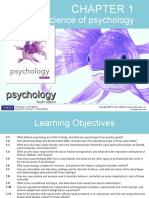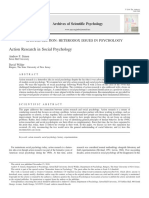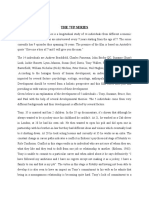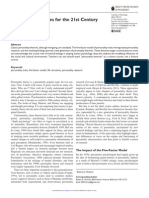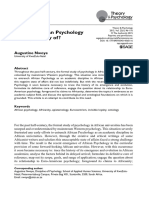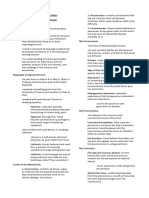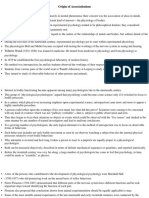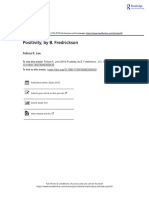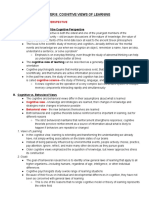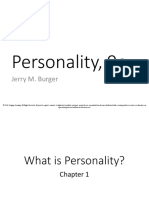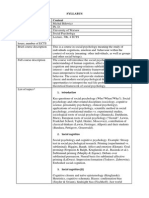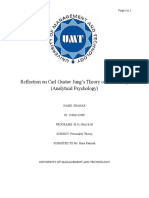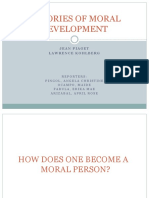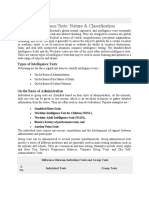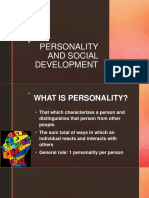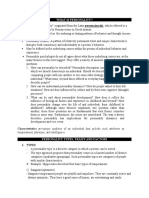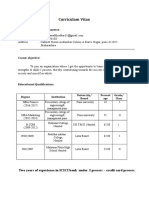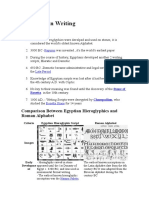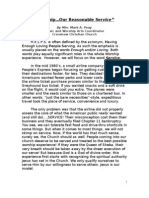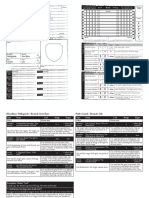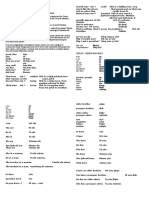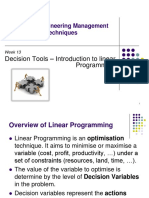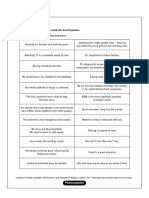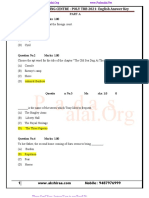Individual Differences: Personality and Intelligence
Katie Page k.page@heythrop.ac.uk Rm W12(Library Wing) Phone: x4271
�What this course is all about
1. 2. 3. 4. Personality Individual Differences Intelligence Psychological testing psychometrics Abnormal behaviour - psychopathology
(c) Katie Page, 2008
�Administration
Contact details Course outline - handout Reading lists Email list Reading pack ready week 2 Helios
Enrolment key (quotient)
(c) Katie Page, 2008
�Weekly anagram LEARN I TO SPY
(c) Katie Page, 2008
�Textbooks
Chamorro-Premuzic (2007). Personality and individual differences. Blackwell Publishing: Maldon, MA. Haslam, N. (2008). Introduction to Personality and Intelligence. Sage Publications: London. Maltby, J., Day, L., & Macaskill, A. (2007). Personality, individual differences and intelligence. Pearson Education Ltd: Harlow, England. Funder, D.C. (2007). The personality puzzle (4th ed.). W. W. Norton & Company, Inc: New York.
(c) Katie Page, 2008
�Student websites
Associated with some texts are student websites which are very useful and informative. wwnorton.com/college/psych/puzzle
Reviews, activities and quizzes (gradebook)
www.pearsoned.co.uk/maltby
Reviews, quizzes, references and advanced readings
(c) Katie Page, 2008 6
�Learning Outcomes
Appreciate why psychologists study personality Be aware of a variety of definitions of personality Understand the components of psychological definitions of personality Develop an understanding of the historical roots of personality theory Understand the major questions that personality theories aim to address Understand the criteria that can be used to evaluate personality theories
(c) Katie Page, 2008 7
�What is personality for you?
STAGE 1: Alone, jot down a few words or a sentence or two which captures your definition or thoughts about personality Do not confer at this stage STAGE 2: Compare this with your friends definitions How do they match? How are they different? What can explain these differences?
(c) Katie Page, 2008 8
�No two persons are born exactly alike; but each differs from the other in natural endowments, one being suited for one occupation and the other for another. (Plato) Every man is in certain respects (a) like all other men, (b) like some other men, (c) like no other man" (Murray & Kluckhohn, 1953).
(c) Katie Page, 2008
�Individual Differences
(c) Katie Page, 2008
10
�To what extent do you agree with the following statement?
Every individual is different?
1 Strongly Disagree 2 Slightly Disagree 3 Disagree 4 Neither agree nor disagree 5 Agree 6 Slightly Agree 7 Strongly Agree
(c) Katie Page, 2008 11
�That people differ from each other is obvious. How and why they differ is less clear = personality and individual differences
(c) Katie Page, 2008
12
�Definitions
Latin persona meaning mask Differential psychology aims to explain observable differences between individuals in terms of underlying psychological determinants (Chamorro-Premuzic, 2007; 2)
Personality A dynamic organisation , inside the person, of psychophysical systems that create the persons characteristic patterns of behaviour, thought and feelings (Allport, 1961; 11) An individuals characteristic pattern of thought, emotion, and behaviour, together with the psychological mechanisms hidden or not behind those patterns (Funder, 2007; 5)
(c) Katie Page, 2008 13
�Key Components
Psychological construct Inside / internal Stable (trait versus state) Multiple components thought, feelings, behaviour Individual level not group measurements issues
(c) Katie Page, 2008
14
�Scope
Personality psychology addresses three parts of the psychological triad: a combination of how people think (cognition), feel (affect) and behave (action). Broader than many other areas of psychology Tries to understand the big picture Contributes to developmental, social, cognitive, biological areas.
(c) Katie Page, 2008 15
�Aims of Studying Personality
Motivational basis
Basic nature of human beings , what drives behaviour?
Provide descriptions or categorisations of how individuals behave Measuring personality Developmental theories
When does personality start to develop?, is it fixed or does it change across the lifespan?
Heritability versus environment Understand mental illness and abnormal behaviour.
(c) Katie Page, 2008 16
�TRAITS
MOTIVATION
BEHAVIOUR
MOOD
SITUATIONAL FACTORS
Adapted from Chamorro-Premuzic, 2007
(c) Katie Page, 2008
17
�The Basic Criteria That a Theory of Personality Should Satisfy
Figure 1.4
The basic criteria that a theory of personality should satisfy
(c) Katie Page, 2008 18
�Basic Criteria - I
Description
Bring order to complexity of behaviours Should simplify, identify and clarify important issues
Explanation
Understand the why Must explain how and why commonly observed instances of behaviour occur
(c) Katie Page, 2008 19
�Basic Criteria - II
Empirical validity
Generate predictions which can be empirically tested leads to validity Can it predict future behaviour in particular situations?
Testable concepts
Can the concepts in the theory be operationalised in order to allow testing? Concepts must be precise, independent and not vague and abstract with multiple possible meanings
Comprehensiveness
Encompass and explain a wide variety of both normal and abnormal behaviour Impossible (perhaps) to explain all therefore theories often limited in scope
(c) Katie Page, 2008 20
�Basic Criteria - III
Parsimony
Economical Trade-off between complexity/comprehensiveness and parsimony
Heuristic Value
Stimulates research and interest in the area
Applied Value
Wider context Practical usefulness solve applied problems
(c) Katie Page, 2008 21
�DEEPCHAT - acronym
D - description E - evaluation E empirical validity P - parsimony C - comprehensiveness H heuristic value A applied value T testable concepts
(c) Katie Page, 2008 22
�Clarification - Terminology
Allport (1937 publication) personality
Key publication started the field
Individual differences term used by psychometricians who develop accurate measures of differences between people (really individual differences in personality)
(c) Katie Page, 2008
23
�Themes and Issues
Awareness / unconscious Concept of self Unique vs general laws
Idiographic vs nomothetic
Person vs situation Philosophical view of person Past, present, future Feeling, thoughts and behaviour
(c) Katie Page, 2008 24
�Feature Strategy
Idiographic Emphasises the uniqueness of individuals To develop an in-depth understanding of the individual
Nomothetic Focuses on similarities between groups of individuals. To identify the basic structure of personality. Minimum number of traits necessary universal personality. Quantitative: structure, measures and relationships are key
Goal
Research Methodology
Qualitative case studies
Data Collection
Interviews, diaries, narratives, treatment, session data
Depth, lose no information Difficult to generalise
(c) Katie Page, 2008
Self-report personality questionnaires
General principles, parsimony May not be accurate for any one person. Training needed to analyse profiles. 25
Advantages Disadvantages
�Five Approaches
1. 2. 3. 4. Trait / dispositional Biological/evolutionary Psychoanalytic Phenomenological / humanistic / crosscultural 5. Behavioural / social learning / cognitive
Cognitive sometimes separate chapter/approach
(c) Katie Page, 2008
26
�Trait / Dispositional
Key researchers / theorists Shelldon, Allport, Eysenck, Cattell, Gray Key claim Aim for parsimony and to find basic structure Key Features Assumption of stability Lexical approaches, five factor model Measurement is important factor analysis Types, categories of people / traits Biological basis (?)
(c) Katie Page, 2008 27
�Psychoanalytic
Key researchers / theorists Freud, Jung, Adler, Horney Key claim (s) Importance of unconscious motivation Key Features Unconscious processes & conflict Freud - personality 3 structures (id, ego, superego) Adler inferiority 4 personality types, birth order Jung - psyche (opposing forces) Myers-Briggs Horney cultural and social factors, neurotic personalities, 10 needs
(c) Katie Page, 2008 28
�Biological / Evolutionary
Key researchers / theorists Darwin, Gray, Eysenck, Cloniniger, Buss Key claim (s) Adaptation and evolutionary theory Key Features Family studies, twin studies and adoption studies Heritability estimates Neuropsychological evidence Physiological evidence neurotransmittors Animal research
(c) Katie Page, 2008 29
�Phenomenological / humanistic / cross-cultural
Key researchers / theorists Maslow, Rogers (Ellis - ?) Key claim (s) Importance of personal growth Key Features Historical existential philosophy Humans by nature are positive and kind Here and now is the focus Personal responsibility and free will Phenomenology individual experience and consciousness
(c) Katie Page, 2008 30
�Behavioural / social learning / cognitive
Key researchers / theorists Pavlov, Watson, Skinner, Dollard & Miller, Bandura, Rotter, Mischel Key claim (s) Learning is key no inner motives Key Features Person-situation debate Empiricism rigorous methodologies Some cognitive elements Self-regulation & self efficacy Locus of control
(c) Katie Page, 2008 31
�PART 2:
INTELLIGENCE
(c) Katie Page, 2008
32
�Overview
Why does intelligence matter?
Implicit theories of intelligence
What is intelligence?
Psychological definitions
Theories and themes
(c) Katie Page, 2008
33
�Why does intelligence matter?
Ones perception and evaluation of our own and others intelligence matters affects lots of choices and judgements In all of these domains In friendships intelligence plays a role. We want out partners to be In love intelligent. Employers will choose a more intelligence In work employer over a less intelligent
one
(c) Katie Page, 2008
34
�Implicit theories
Definition
Peoples everyday ideas about a particular topic
Importance
1. Influential in everyday life 2. Can give rise to more formal theories 3. Provide avenues to research when explicit theories are wrong 4. Can inform theories about psychological constructs, such as development of intelligence or cross-cultural aspects
(c) Katie Page, 2008 35
�Implicit Theories: Research
Sternberg et al (1981)
61 college students, 63 people entering supermarket, 62 waiting for a train List behaviours characteristic of everyday intelligence, academic intelligence or unintelligence 122 other people rated how well each of the behaviours reflected aspects of intelligence
(c) Katie Page, 2008
36
�Sternberg Results
3 dimensions of intelligence
1. Practical problem solving 2. Verbal ability 3. Social competence
(c) Katie Page, 2008
37
�Practical Problem Solving (PPS)
Ability to be practical and logical Ability to analyse situations well and engage in a decision making process that involves reasons Find alternative solutions and viewpoints to a problem Student has a problem with an essay Good PPS explore the topic, talk to lecturer, re-looking at lecture notes, research key papers and ask questions Bad PPS complain how hard it is and then head to the pub!
(c) Katie Page, 2008
38
�Verbal Ability
Ability to express oneself converse with others confidently Understand correct meanings for words, uses language confidently Competent use of antonyms and analogies Good reading skills
(c) Katie Page, 2008
39
�Social Competence
High levels of knowledge, understanding, competency, motivation, and confidence in terms of themselves and others High self-awareness, good interpersonal skills, good balance between independence and interdependence Takes personal responsibility and has positive regard for others
(c) Katie Page, 2008 40
�1981 Sternberg Study
Laypeople implicit theories
1. 2. 3. 4. 5. 6. Practical problem-solving ability Verbal ability Intellectual balance and integration Goal orientation and attainment Contextual intelligence Fluid thought
(c) Katie Page, 2008
41
�Issues with implicit theories
These theories differ significantly:
Between cultures By experts Across the life-span
(c) Katie Page, 2008
42
�Lay-persons Implicit Theories of Intelligence (Taiwanese Chinese)
A general cognitive factor of intelligence Inter-personal intelligence Intra-personal intelligence Intellectual self-assertion Intellectual self-effacement.
(Yang & Sternberg, 1997)
�Implicit Theories of Intelligence by Countries Around the World
�EXERCISE RATE YOU OWN COUNTRY
(c) Katie Page, 2008 45
�Similarities and Differences Between Expert Implicit Theories of Intelligence Across Academic Disciplines (Sternberg, 1985)
�Dictionary Definitions
The ability to understand, a greater or lesser capacity to know or learn. A group of all the functions whose objective is knowledge (sensation, association, memory, imagination, understanding, reason, conscience).
(c) Katie Page, 2008
47
�Problems
First definition aspects related to learning that do not have much to do with intelligence, such as memory in its distinct dimension of the memory manager, are included. The second is definition is excessively generic.
(c) Katie Page, 2008
48
�What is intelligence?
Everyday definitions ability to think abstractly ability to learn quickly ability to adapt to environment
(c) Katie Page, 2008
49
�Definitional Issues
Discussed widely No one definition which is widely accepted Single general ability or does it encompass a wide range of skills, aptitudes and talents?
(c) Katie Page, 2008
50
�What is intelligence?
Psychological definitions: the ability to judge, comprehend, or reason mental abilities that enable one to adapt to, shape, or select ones environment the ability to understand and deal with people, objects and symbols
(c) Katie Page, 2008
51
�The Bell Curve
Controversial Led to many debates APA task force
What is current state of knowledge?
(c) Katie Page, 2008
52
�Overview of Theories
Spearman g factor Thurstone primary mental abilities Gardners theory of multiple intelligences Sternbergs triarchic theory of intelligence Cattell fluid vs crystallised intelligence Emotional intelligence
(c) Katie Page, 2008
53
�Measuring Intelligence
Galton Intelligence Scale Binet-Simon Intelligence Scale Wechsler Adult Intelligence Scale (WAIS) and Wechsler Intelligence Scale for Children (WISC)
(c) Katie Page, 2008
54
�Summary
Next week: psychoanalytic approaches & phenomenological approaches to personality Questions? I am the
third force!
(c) Katie Page, 2008
55





